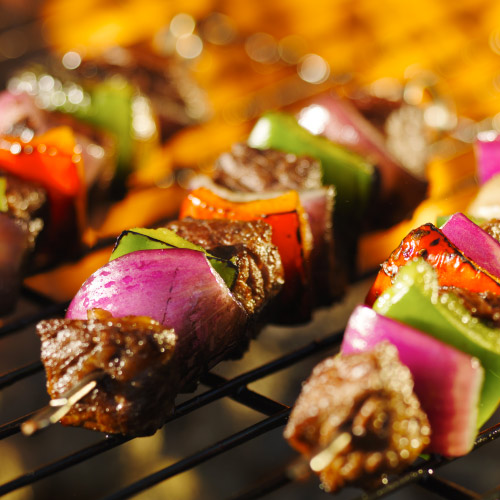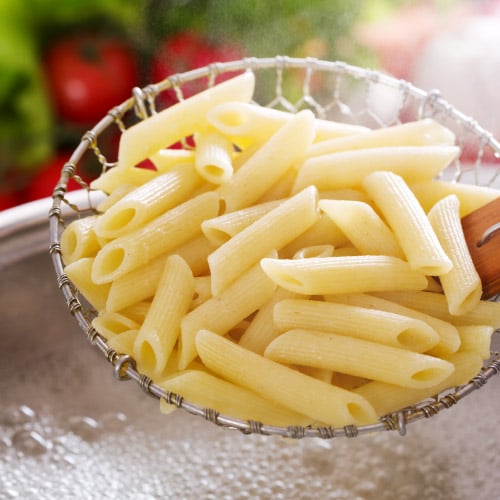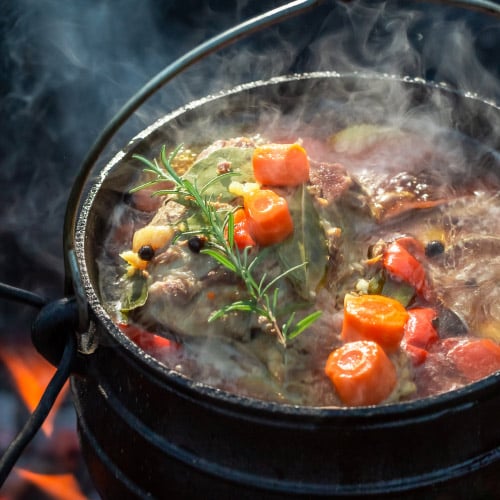Examples of Tender Beef How to Regulate Temperature When Frying
Types of Cooking Methods
Last updated on xi/17/2020
The 3 types of cooking methods are dry heat cooking, moist heat cooking, and combination cooking. Each of these methods uses estrus to impact foods in a dissimilar manner. All cooking techniques, from grilling to steaming, can be grouped under ane of these 3 methods. Understanding and mastering the unlike types of cooking methods is essential to becoming a nifty chef or home cook. Cognition of cooking techniques allows you to work with a multifariousness of ingredients and kitchen equipment to accomplish consistent, flavorful results in your cooking. Go along reading to learn about the 3 main types of cooking, all the techniques that fall under those types, and the foods that are complemented by these techniques.
Click any of the cooking methods below to learn more than:
- Broiling
- Grilling
- Roasting
- Baking
- Sauteing
- Poaching
- Simmering
- Boiling
- Steaming
- Braising
- Stewing
- Glossary
ane. Dry out Rut Cooking

Dry oestrus cooking works without the presence of whatsoever moisture, broth, or water. Instead, it relies on the circulation of hot air or contact with fatty to transfer estrus to foods. Temperatures of 300 degrees or hotter are used to create browning, a reaction where the amino acids and sugars in food turn brown and create a distinct olfactory property and flavor. The unique scents of toasted staff of life or seared meat are both examples of dry heat cooking at work.
Broiling
Broiling works by transferring extremely high rut onto food, unremarkably directed from a radiant located to a higher place the nutrient which cooks on one side at a time. Browning tin occur very quickly with this method, sealing juices and flavor inside and leaving a crisp exterior. Because this cooking method is fast, it's helpful to use a timer or check the doneness so foods don't go burnt or overcooked. In commercial kitchens, broiling can exist performed with a salamander or broiler oven.
Best foods for broiling:
- Meats: Broiling works best on thinner cuts of meat, like steaks, pork chops, or hamburger patties. Tender cuts are preferred because the dry heat will quickly evaporate moisture and dry out out the meat.
- Poultry: Use chicken or turkey cutlets, breast halves, quarters, and legs in the broiler for flavorful results.
- Fish: Choose thick, sturdy fish, similar salmon, that can handle high rut and won't dry out out hands.
- Fruits and Veggies: Broiling can even be used on fruits and vegetables. Try broiling peaches or grapefruit for a unique menu item.
Grilling
Grilling is similar to broiling, in that it uses radiant oestrus to melt foods apace. Most commonly, grilling equipment volition feature an open grate with a heat source located below the food. Flipping is required to cook foods on both sides and grill marks from the hot grate or rack are desirable.
All-time foods for grilling:
- Burgers: Basis hamburger meat is moist and cooks up very well on a hot grill. The loftier heat sears the outside of the patty for succulent charred flavor.
- Meats: The dry heat from grilling will quickly remove moisture from meat so it's best to cull tender cuts or marinate the meat first. Ribeyes, porterhouses, t-bones, and strip steaks have higher fat content and marbling that produces a delicious grilled steak.
- Poultry: Boneless cuts of craven piece of work best because they will grill more evenly. Whole chickens tin be grilled, only spatchcocking is recommended.
- Fish: Salmon, tuna, and swordfish steaks are sturdy enough for the grill and won't dry out rapidly. It's possible to wrap fish in foil before placing it on the grates to foreclose it from falling through.
Roasting
Roasting is performed inside an oven and uses indirect oestrus that cooks from all sides for fifty-fifty browning. This method of cooking works more slowly, coaxing flavors out of meats and vegetables. Roasting can be performed at very depression temperatures between 200 degrees and 350 degrees Fahrenheit for tougher cuts of meat, or college temperatures up to 450 degrees Fahrenheit for more tender cuts.
All-time foods for roasting:
- Meats: Roasting cooks big cuts of meat slowly and evenly. Prime rib, beef tenderloin, pork butt or shoulder, and pork loin all benefit from roasting.
- Poultry: Whole chickens or turkeys can be placed in a roasting pan or on a rotisserie spit and cooked for several hours for a moist and flavorful product.
- Fruits and Veggies: Roasting is a bang-up manner to bring out the best qualities in fruits and vegetables. Grapes, cherries, and tomatoes tin be roasted to intensify their flavors. Pumpkin, squash, eggplant, and cauliflower are also excellent candidates for roasting.
Blistering
Baking and roasting both apply indirect heat to surround foods and cook from all sides. The term roasting is used when cooking meats or vegetables, and baking is used when making bread, rolls, and cakes. Technically, these cooking methods are the aforementioned, but baking is usually performed at lower temperatures than roasting.
All-time foods for baking:
- Baked Appurtenances: Baking transforms wet dough or batter into a last product with a business firm texture. Bread, pastries, and cakes are all baked.
- Pizza: As pizzas are baked in a hot oven, the dough becomes house, a crust is formed, and the cheese topping melts.
- Meats: Sauteing cooks quickly, and so tender meats work all-time. Use ground beefiness, tenderloin, or medallions in a saute pan. Pocket-sized, uniformly sized cuts of meat brown evenly.
- Poultry: Boneless breasts, strips, or cutlets tin can be sauteed to sear in flavor.
- Vegetables: Zucchini, squash, and leafy greens tin can all exist sauteed in olive oil or butter. Carrots, celery, and onions can also be sauteed and oftentimes brand a flavorful base for other dishes.
- Eggs: Poaching is a common method of cooking eggs that results in a soft, tender egg white and creamy yolk. No oil is needed so it's more than health-conscious than pan frying.
- Poultry: Broth, vino, or aromatics can be used for poaching liquid, which adds flavor to boneless, skinless chicken breasts. The effect is tender chicken that can exist cubed, sliced, or shredded and added to salads, pasta, or sandwiches.
- Fish: Poaching is a groovy mode to preserve the delicate texture of light fish like tilapia, cod, and sole. A special broth, called court bouillon, is used to add season to the fish every bit it cooks.
- Fruit: Apply a sweetened liquid to poach fruits similar pears or apples for a unique dessert. The flavour of the fruit is deepened and the texture becomes soft and tender. Whatever leftover liquid can be used to brand a flavored syrup to serve with the fruit.
- Rice: Simmering produces cooked rice with a lite, fluffy texture. Using h2o that is boiling or too hot causes the rice to get sticky and dry.
- Meats: Cull tougher cuts of meat that will release fat and collagen every bit they simmer, similar chuck roast.
- Soups and Stocks: Considering simmering releases the fat and proteins from meat, it produces a rich flavorful broth that tin be used in soups or stews.
- Vegetables: Tough root vegetables like potatoes and carrots are cooked to the perfect texture with gentle simmering.
- Grains: Grains similar quinoa, oats, or millet can be simmered until they reach a soft edible texture. Hot cereal is fabricated by simmering grains until most of the water has evaporated, creating a smooth porridge.
- Legumes: Dried beans and legumes are simmered to achieve a soft, edible texture. Some types of beans, like lentils, cook quickly, while others have several hours of gentle simmering to become fully cooked.
- Pasta: Pasta may come to mind as one of the virtually commonly boiled foods. The hot water cooks the pasta quickly then that it tin can exist removed from the water before starches break down, preventing a mushy texture.
- Eggs: Boiling eggs in their shell produces hard- or soft-boiled eggs. The texture of the yolk tin range from firm to creamy, depending on the melt fourth dimension.
- Vegetables: Tough root vegetables similar potatoes and carrots will cook more chop-chop in boiling water simply information technology's recommended to exam their tenderness with a fork so they don't overcook.
- Vegetables: Well-nigh vegetables can be steamed with peachy results. Sturdy veggies like beets, carrots, and potatoes volition steam for longer than frail foods like leafy greens.
- Fish and Shellfish: For more flavorful results, broth or wine can be used instead of h2o. Fish stays tender and shellfish like clams, mussels, lobster, or venereal are cooked inside their shells.
- Desserts: Some types of desserts are steamed rather than baked, producing a moist, silky texture. Creme brulee, flan, and panna cotta are all custards fabricated by steaming.
- Tamales: Tamales are a popular food made by steaming masa, a dough made of basis corn, and fillings inside a corn husk packet. The steam makes the corn dough tender and moist.
- Meats: Braising is almost usually used with cheaper, tougher cuts of meat because information technology softens and tenderizes the muscle fibers. Choose pork shoulder, chuck roast, or lamb shank.
- Vegetables: Vegetables tin be braised along with meat to add more than flavour, or they can exist braised alone as their own dish. Root vegetables like potatoes, beets, and turnips are softened during braising. Celery and fennel also respond well to braising, arresting liquid but maintaining a firm texture.
- Legumes: Lentils, chickpeas, and green beans can be braised in broth or vino for a texture that'south soft simply non mushy.
- Meats: Meats that are rich in collagen and fat do well in a stew pot. Avoid lean cuts and choose brisket, oxtail, or chuck roast.
- Vegetables: Vegetables add depth to your stews. Onions, carrots, potatoes, and celery are common choices for building a stew, simply also consider parsnips, turnips, or rutabaga.
- Al Dente - describes pasta that is firm and slightly undercooked
- Baste - to pour juices or liquid fat over meat while it cooks
- Blanch - to scald food in boiling water for a quick moment and then place it in common cold h2o to stop the cooking procedure
- Brunoise - to cut foods in to a 1/8" size die
- Caramelize - to oestrus sugars until they are browned
- Chiffonade - to coil up leafy greens or herbs and cut into long, sparse slices
- Clarify - to melt butter and separate the solids from the butterfat
- Cure - to preserve foods by calculation salt and cartoon out moisture
- Deglaze - to dissolve browned food residual in a hot pan with liquid
- Dredge - to coat moist foods in a dry ingredient, like flour
- Emulsify - to blend two liquids similar oil and water
- Fillet - to cutting a portion of meat or fish
- Flambe - to embrace a food in a flammable liquid, similar brandy or rum, and lite information technology briefly on burn
- Fold - to incorporate an ingredient with a conscientious motility that retains air
- Julienne - to cut foods into long thin strips
- Meuniere - a method of cooking, usually used with fish, in which the food is lightly dusted with flour and sauteed in butter
- Parboil - to precook foods past boiling for a short time
- Reduce - to thicken a liquid mixture past boiling or simmering, causing wet to evaporate
- Scald - to rut a liquid just to the boiling indicate
- Spatchcock - to split open a whole craven or turkey for easy grilling
Sauteing
Sauteing is performed over a burner in a hot, shallow pan and uses a minor amount of oil or fatty to coat food for even browning. This method cooks foods very apace then it's best to continue the food moving by tossing or flipping. Saute is a French word that translates to "spring". To achieve great results with sauteing, make sure the oiled pan is hot before adding whatsoever food, don't overcrowd the pan with besides many items, and stir or toss oft.
All-time foods for sauteing:
2. Moist Heat Cooking

As the proper name indicates, moist oestrus cooking relies on the presence of liquid or steam to cook foods. This method can be used to make healthy dishes without any added fat or oil. It's also a corking way to tenderize the tough fibers in certain cuts of meat, like beef chuck or brisket. When cooking fibrous vegetables and legumes, moist rut cooking softens the nutrient until it reaches the perfect tenderness. Different dry heat cooking methods, moist heat cooking will non produce a browned crust.
Poaching
Poaching is a gentle method of cooking in which foods are submerged in hot liquid between 140 degrees and 180 degrees Fahrenheit. The depression heat works especially well for delicate items, and wet and flavour are preserved without the demand for fat or oil.
Best foods for poaching:
Simmering
Simmering is also a gentle method of cooking foods but uses higher temperatures than poaching, usually between 180 degrees and 205 degrees Fahrenheit. This temperature range lies beneath the boiling point and produces tiny bubbles. To attain a simmer, first bring water to the boiling point and then lower the temperature.
Best foods for simmering:
Boiling
This cooking technique involves submerging nutrient in water that has been heated to the humid point of 212 degrees Fahrenheit. The boiling water produces large bubbles, which go along foods in motion while they melt. The expression slow eddy means that the water has just started to produce large, deadening-moving bubbles only is not quite heated to the boiling temperature. A total boil occurs at the humid point and results in fast-moving, rolling bubbles. Steam is as well released from the h2o as information technology boils.
Best foods for boiling:
Steaming
In steaming, water is boiled continuously to produce a steady corporeality of steam. The steam surrounds foods and cooks evenly while retaining moisture. Steaming can exist performed in a few different means. For high volume kitchens, a commercial steamer or combi oven is the most efficient. Other methods of steaming include using a pot and steamer basket, using a microwave, or wrapping foods in foil so they can steam in the oven.
Best foods for steaming:
3. Combination Cooking

Combination cooking utilizes both dry and moist cooking methods. Foods are cooked in liquids at low heat for an extended menstruum of time, resulting in a fork tender product. This technique works with the toughest cuts of meat, gradually breaking down fibers until they melt into the liquid.
Braising
During braising, foods are first seared in a hot oiled pan and then transferred to a larger pot to cook in hot liquid. The foods are merely partially submerged in simmering water, broth, or stock. Using depression heat, the foods soften over an extended cook time and the liquid becomes reduced with intensified flavors. Braising is a great method for producing fork tender meats that fall off the bone.
Best foods for braising:
Stewing
The key difference betwixt stewing and braising is that foods are completely submerged in hot liquid while stewing instead of being partially submerged. Smaller cuts of meat are used in a stew, but the method of slow cooking at low heat is the same. As the stew cooks, gristly vegetables intermission downward and fat and collagen from the meats melt abroad. The effect is a thick, flavorful gravy filled with tender bites of meat and soft vegetables.
Best foods for stewing:
Glossary of Cooking Terms
Equally you follow recipes, you might come beyond some cooking terms that are unfamiliar to you lot. We've added descriptions of some of the near common cooking terms below:
With a basic understanding of the three type of cooking methods, you tin cull the best technique to use for each dish you prepare. As you lot create your ain signature recipes, yous'll know how to employ dry out cooking to attain a crispy, dark-brown outside on meats, or how to use moist cooking to continue your meats fork tender. When needed, you'll know when to use a combination of dry and moist heat to transform tough cuts of meat into succulent, juicy morsels.
Source: https://www.webstaurantstore.com/article/454/types-of-cooking-methods.html
0 Response to "Examples of Tender Beef How to Regulate Temperature When Frying"
Post a Comment